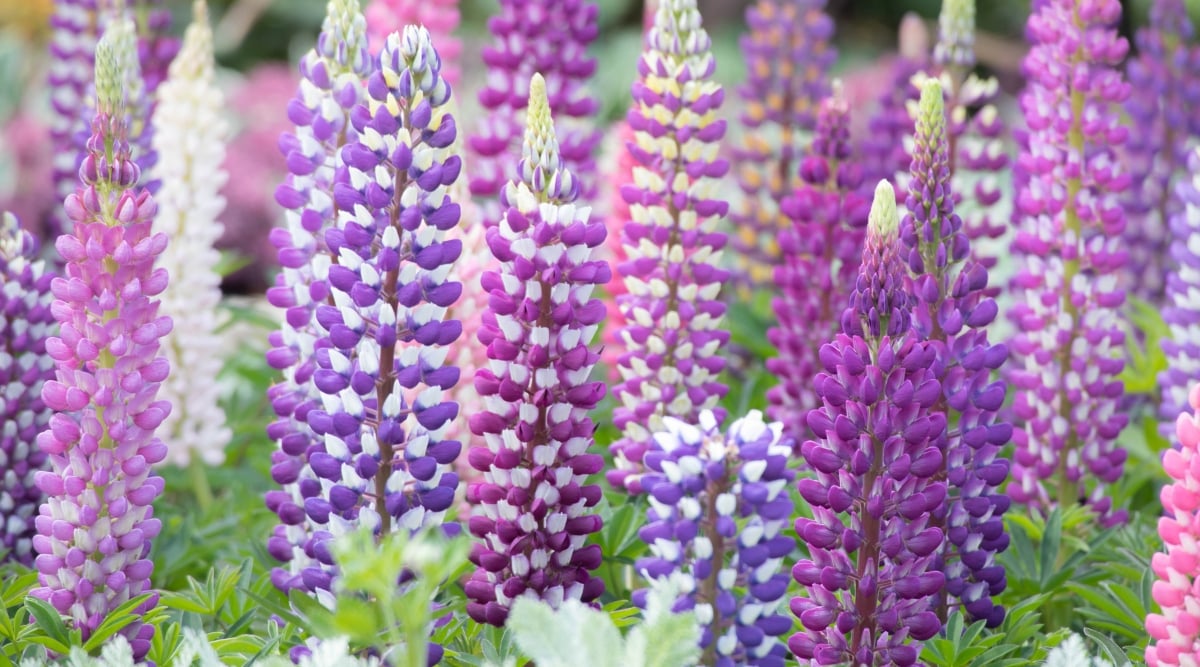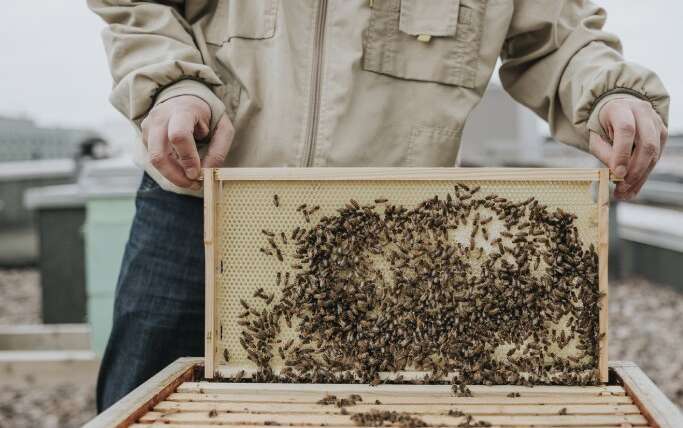A late spring superstar with pink, purple, red, white, and yellow spikes standing tall in landscapes from zones 4 through 8, lupines have a distinct flower shape and a unique horticultural profile. From a distance, they resemble other vertical perennials like foxglove, salvia, and delphinium, but up close, they reveal themselves to be something more complex.
Lupines are actually members of the pea family (Fabaceae), and on closer inspection, you can see that their flower petals resemble the shells of a legume. Their leaves are also unusual, with a palmate structure that fans outward from several branch points below the flower head.
There are nearly 200 species of lupine and thousands of cultivars. Plants range in height from 1 to 4 feet and grow best in locations with full sun to partial shade. The brightly-colored, whorled flowers are highly attractive to birds and pollinators, and their seed pods are robust. They are nitrogen fixers, which means they convert air to ammonia and naturally boost the soil’s nitrogen content.
The growing tags in your local garden center may label lupines as perennial plants, but they don’t always behave that way. Some seem to die off after a season or two, while others seem to bloom every other year. Some spread like wildfire, earning them an invasive reputation. So, what gives? Are lupines annual, biennial, or perennial flowers?
Gardeners wanting to grow lupines should know the answer to these and other pressing questions. To help clear the air, we’ll explore the differences between annual, biennial, and perennial flowers. We’ll also look at their growth habits and flowering patterns.
The Short Answer
Lupines can be either annual or perennial plants. There are no true biennial lupines.
The Long Answer
 The lupine genus is notorious for its variability in hardiness, with some species having short lifespans.
The lupine genus is notorious for its variability in hardiness, with some species having short lifespans.
Hardiness varies among species. Some lupines live for just a short time, and the genus is temperamental in captivity. Lupines may behave like annual, biennial, or perennial plants in different scenarios and climates. Let’s look at the three plant categories related to this genus and explore a few species from each group (where applicable).
Annual Lupines
 Some lupine species are highly adaptable to poor soil conditions.
Some lupine species are highly adaptable to poor soil conditions.
By definition, an annual plant goes from seed to seed in a single growing season. It grows, blooms, produces seeds, and dies completely. Highly tolerant of imperfect soil, quite a few species of lupines will reseed themselves liberally once established, and they can take over a large area quickly.
In parts of California, Texas, Oklahoma, Florida, and the mountainous regions of South America, you might see fields of blue every spring and assume you are looking at a returning perennial plant. It is more likely, however, that the lupines you see in the wild are new annual plants that have sprouted from last season’s seeds.
Annual lupines thrive in untended areas but can be difficult to grow in controlled environments, which makes them perplexing and challenging to even the most seasoned dirt diggers. Here are a few annual lupine varieties you may find in natural areas and seed catalogs.
Texas Bluebonnet
These bluebonnets boast fan-shaped leaves that stay green for most of the year in warmer areas.
One of the most well-known annual lupines is Lupinus texensis or the Texas bluebonnet. Averaging 12 to 18 inches in height, this wildflower spreads easily by throwing seed. It is typically glimpsed on roadsides and meadows in southern parts of the U.S. It is also sold as an annual plant hardy in zones 4 through 8.
An impressive sight in early spring, bluebonnets feature white-capped, China blue spires whorled with roughly 50 small flowers that radiate from a dense thicket of stems with taproots. Bluebonnets have fan-shaped leaves that remain green most of the year in warmer regions. This gives the species a designation of ‘winter-hardy’ annual.
Bicolor Lupine
 The flowers of the bicolor lupine create explosive seed pods, aiding soil nitrogen content in disturbed areas.
The flowers of the bicolor lupine create explosive seed pods, aiding soil nitrogen content in disturbed areas.
Thriving in damaged or sandy soil, Lupinus bicolor is an annual plant that grows on a single stem with small, hairy leaves that look like fingers. Ranging in height from 4 to 16 inches, bicolor lupines have small blue and white pea-sized flowers with a light dusting of freckles.
Each flower produces one large, brown seed pod that explodes at the end of the season, launching seeds outward in a 20-foot perimeter. Plants colonize quickly, so they are sometimes planted deliberately to cover large areas of disturbed ground and boost the soil’s nitrogen content.
Arroyo Lupine
 Lupinus succulentus is a tall, California native wildflower with fragrant flowers.
Lupinus succulentus is a tall, California native wildflower with fragrant flowers.
Also known as hollowleaf lupine, Lupinus succulentus is a wildflower species native to California. Quite tall at 2 to 4 feet, arroyo lupines feature spires of lavender and white flowers that are sweetly scented and highly attractive to bees and butterflies.
Arroyos can grow in a wide variety of soil conditions, which makes them extra prolific. They spread seeds through pods that swell and burst at the end of the season and then die off, completing their life cycle as an annual plant.
Perennial Lupines
 Perennial lupines thrive globally due to their beauty and adaptability.
Perennial lupines thrive globally due to their beauty and adaptability.
When planted within their designated hardiness zones, perennial plants will flower, die back at the end of the season, and return next year. Nursery-grown lupines sold for ornamental use are typically herbaceous perennial flowers labeled as such, but so are some of the lupines you’ll see in the wild, particularly in the northeast regions of the United States.
Perennial lupines can be found in backyards worldwide, partially because they are unique and beautiful but also because some of us love a good challenge. Known for being persnickety and short-lived, perennial lupines may flower for just one season or take a few years off and flower again when ready. They may also return fully and faithfully for up to ten years or spread like wildfire in an uncontrolled setting.
You can do everything right from a maintenance and planting perspective, but you never know with lupines. That’s part of the plant’s mystique and, for some, a big part of the draw. Here’s a look at some of our favorites.
Russell Lupine
 Despite their brief lifespan of only a few years, Russell lupines yield robust seeds.
Despite their brief lifespan of only a few years, Russell lupines yield robust seeds.
Lupines in this perennial species and its many hybrids are among the easiest to grow. Flowers can be red, yellow, white, pink, salmon, orange, purple, and bicolor. They range in height from 3 to 4 feet and bloom in late spring or early summer. There are hundreds of cultivars from which to choose. ‘Noble Maiden,’ ‘My Castle,’ and ‘The Governor’ are favorites.
Russell lupines are hardy in zones 4 to 8. They can also be grown as annuals in warmer regions because they have a higher tolerance for summer heat than many other perennial lupines. Their life expectancy is short at just a few years, but they will produce large, hardy seeds that can be direct-sown in the fall to keep the party going.
Tree Lupine
 Before planting lupine, it is essential to study your local region to make an informed decision.
Before planting lupine, it is essential to study your local region to make an informed decision.
Also known as yellow bush lupine, Lupinus arboreus is native to North America’s western coasts and bluffs. Soaring to heights of 5 to 8 feet, flower racemes can be up to 12 inches tall and are usually golden yellow. They rise from a dense thicket of sturdy, palmate foliage that is dark green and glossy.
Hardy in zones 7 to 10, tree lupine will return perennially in warmer regions, but it also has large, durable seeds that will spread liberally like an annual in the Northwest. It has a controversial reputation for being both an erosion savior and a bluffs invader, depending on where you live. Research your region before committing to this one.
Riverbank Lupine
 The plant’s durable seed production adds to its suitability for restoration projects.
The plant’s durable seed production adds to its suitability for restoration projects.
Hardy in zones 7 to 9, Lupinus rivularus grows 3 to 4 feet tall and tolerates varied soil conditions. Featuring narrow spires of whorled, lilac-pink flowers, riverbank lupine has a sweet scent and blooms for up to 4 weeks in early summer.
Its leaves are light green, palmate, and compound, with finer texture than many other lupines. The taproots are substantial, penetrating up to 5 feet deep. This trait, as well as its nitrogen-fixing properties and durable seed proliferation, make riverbank lupine a common choice for restoration landscapes in coastal regions. It can also be aggressive.
Biennial Lupines
 These plants die off completely after they have finished flowering and seeding.
These plants die off completely after they have finished flowering and seeding.
A biennial plant has a two-year life cycle. It sends up a rosette of vegetation in its first year and flowers in its second. After flowering, seeds are formed and dispersed to create more plants in the future, and the original plant dies completely. Many of our most troubling weeds have biennial lifecycles, wild carrot, mullein, and thistle being among the most prolific.
Although lupines may appear to behave this way in certain situations and locations, there are no true biennial lupines. What you are seeing might be an annual lupine that has grown from a previous season’s seed or a perennial lupine that flowered just once before dying. Flowers may also be taking a gap year, as the genus is known for having unreliable bloom cycles.
Final Thoughts
If you’d like to work some lupines into your landscape, purchase a perennial variety from a reputable grower or nursery. Examine the plant tag or seed packet closely to ensure you are not purchasing an annual, and site it in a location where it will not drift into an open, untended area.
Do some research and choose cultivars known for being hardy and reliable. Plant them in full sun to partial shade in well-drained soil, and keep your fingers crossed! With any luck, you’ll be treated to a spiky patch of perennial lupines next spring and for many years after that.



